Gluten-free gravy is a must-have part of many holiday meals. This easy recipe makes a flour-thickened gravy that’s deeply flavorful and a snap to make. You only need three ingredients and about 10 minutes to make a batch.
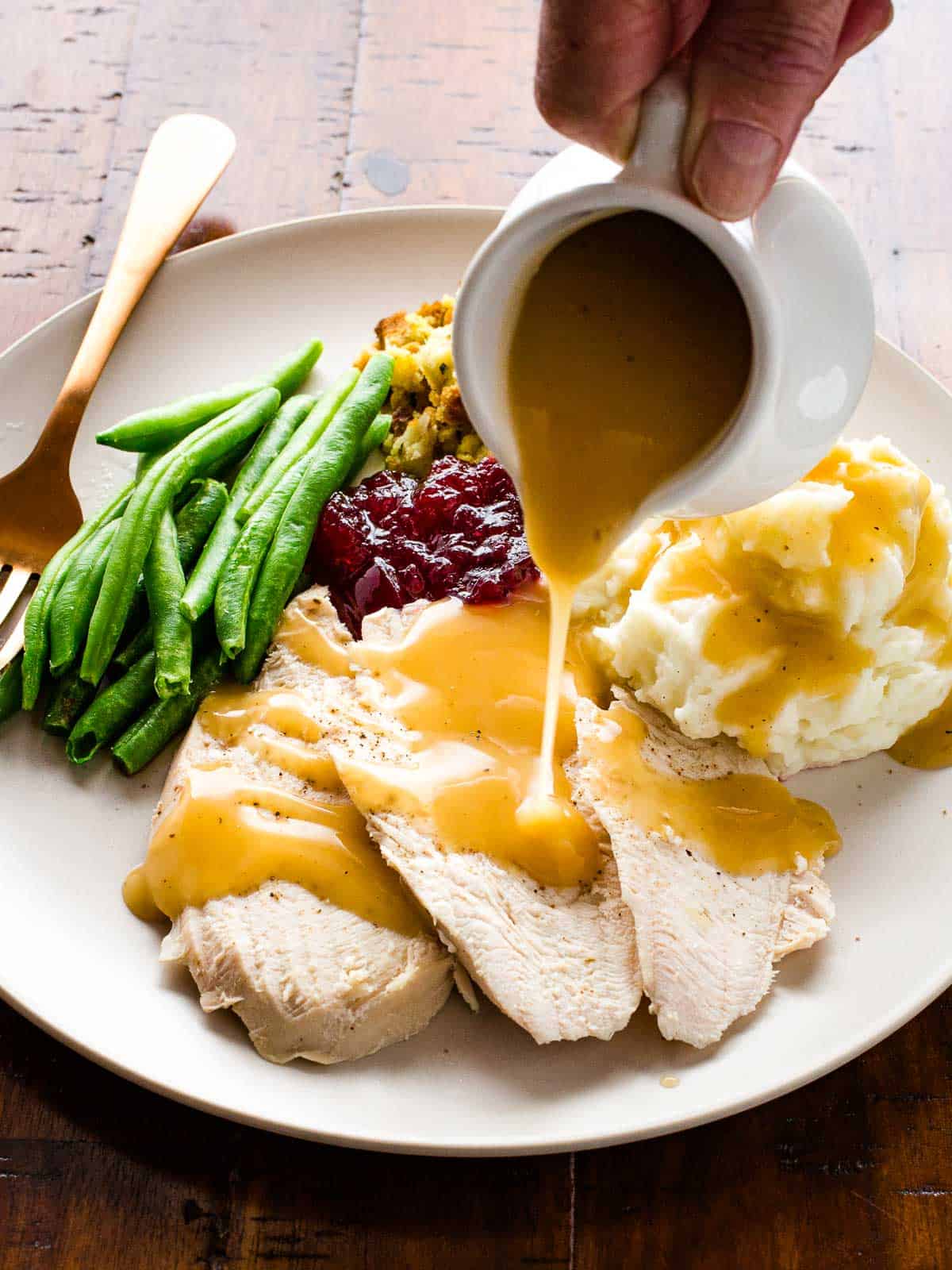
Gravy is one of the best parts of Thanksgiving. The rich, savory flavor enhances everything it touches—from turkey to mashed potatoes to gluten-free stuffing.
And making a gluten-free gravy is surprisingly easy. Here’s everything you need to know to make perfect gravy every time.
Ingredients.
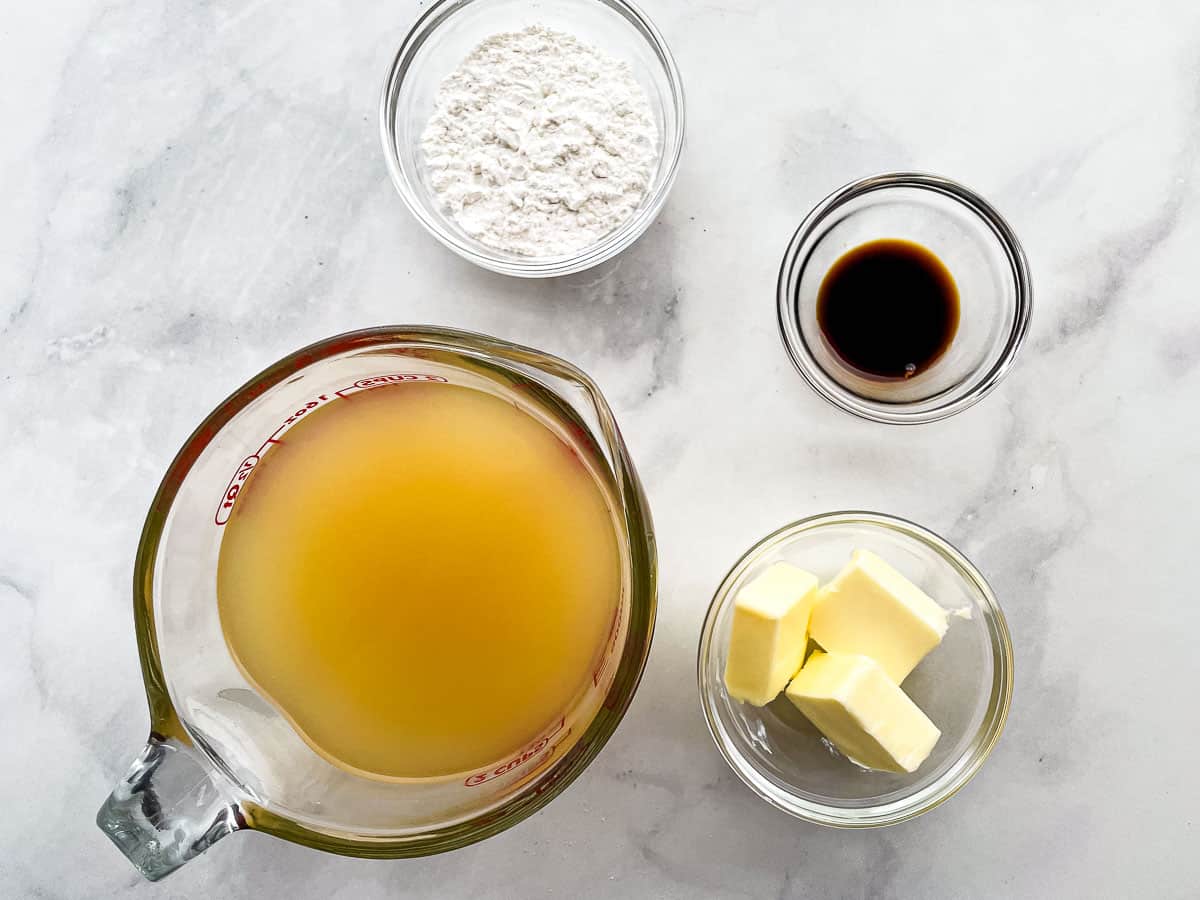
You need three ingredients—plus salt and pepper—to make a great gluten-free gravy.
Butter and Other Oils. The foundation of this gravy is a roux–a combination of fat and flour that’s cooked together. Here’s what you can use. Feel free to use one of these or a combination.
- Butter. Classic ingredient in gravy. Use either salted or unsalted butter.
- Olive Oil. Extra-virgin olive oil works great in this recipe.
- Pan Drippings. This is the fat left behind after roasting your turkey or other meat. Scrape the drippings from the bottom of the pan. Don’t use burnt pan drippings or your gravy will have an unpleasant flavor.
- Dairy-Free Buttery Spreads. If you want to make a dairy-free gravy with a buttery flavor, use your favorite dairy-free butter.
- Bacon Fat. You can use the fat that remains in the pan after cooking bacon. It adds a smoky flavor to the gravy.
Rice Flour and Other Gluten-Free Flours. What to Use and What to Avoid.
Flours to use.
- Sweet Rice Flour. Makes a very smooth gluten-free gravy.
- White Rice Flour. Works really well. Especially finely ground white rice flour.
- Whole Grain Gluten-Free Flour (brown rice, millet, sorghum) Gravy made with a whole-grain gluten-free flour, like brown rice flour, tastes nutty and, depending on the flour, can have a slightly gritty texture.
Flours to avoid.
- Gluten-Free Flour Blends. Premixed gluten-free flour blends often contain starches and other thickeners, like xanthan gum. They can be unpredictable in gluten-free gravy. Some work great. Others get really thick and clumpy. I avoid them for this reason.
- Almond Flour. Made from ground almonds, almond flour doesn’t provide thickening power and can’t be used in this recipe.
- Coconut Flour. Makes an unappetizing thick gravy with a strong coconut flavor.
Stock or Broth. Homemade or high-quality broth or stock are perfect for making gravy. If you’re buying the stock, be sure it’s salt-free or low-salt. As the gravy cooks, the salt can concentrate. This means your gravy can go from great to salty in just a few minutes. Always check ingredients to ensure the stock is gluten-free.
And remember, you can always use the roasting liquid in the bottom of the pan. Before using it, strain it and remove the excess fat so your gravy isn’t greasy. If you plan to use the pan drippings, be sure to have stock or broth on hand. Sometimes pan drippings burn or there’s not enough liquid to make gravy.
A note about bouillon paste or cubes. A quick opinion for making gravy is to use bouillon paste or cubes. Reconstitute them according to the package. You need enough for two cups. Some brands of bouillon are salty. Look for a low-salt version. Check current ingredients to ensure the bouillon is gluten-free.
Seasonings: Salt, Pepper, and Other Ways to Add Flavor.
No one wants a bland gravy. Here’s what to use to season your gravy for the best flavor.
- Salt. Add salt to the gravy at the end of cooking. If salt is added too early, it can concentrate and make the gravy too salty.
- Pepper. Freshly ground black or white pepper adds a little heat to the gravy. Some folks don’t like pepper in their gravy. It’s fine to leave it out. Add it to taste along with the salt.
- Gluten-Free Soy Sauce. A nice flavor booster is a little gluten-free soy sauce or tamari. Both add umami. A mere teaspoon boosts the savoriness of gravy. If you’re using soy sauce, add it before seasoning with salt. (Remember to use gluten-free soy sauce!)
- Fresh Herbs. If you’ve got the time, simmer your gravy with a few springs of fresh thyme or some parsley. They lend a freshness to rich gravies. After about 30 minutes, remove the herbs.
How to Make Gluten-Free Gravy.
Let’s take a look at the steps needed to make gluten-free gravy. By the way, for this recipe, you’ll need a medium saucepan and a whisk.
Step One: Make the Roux.
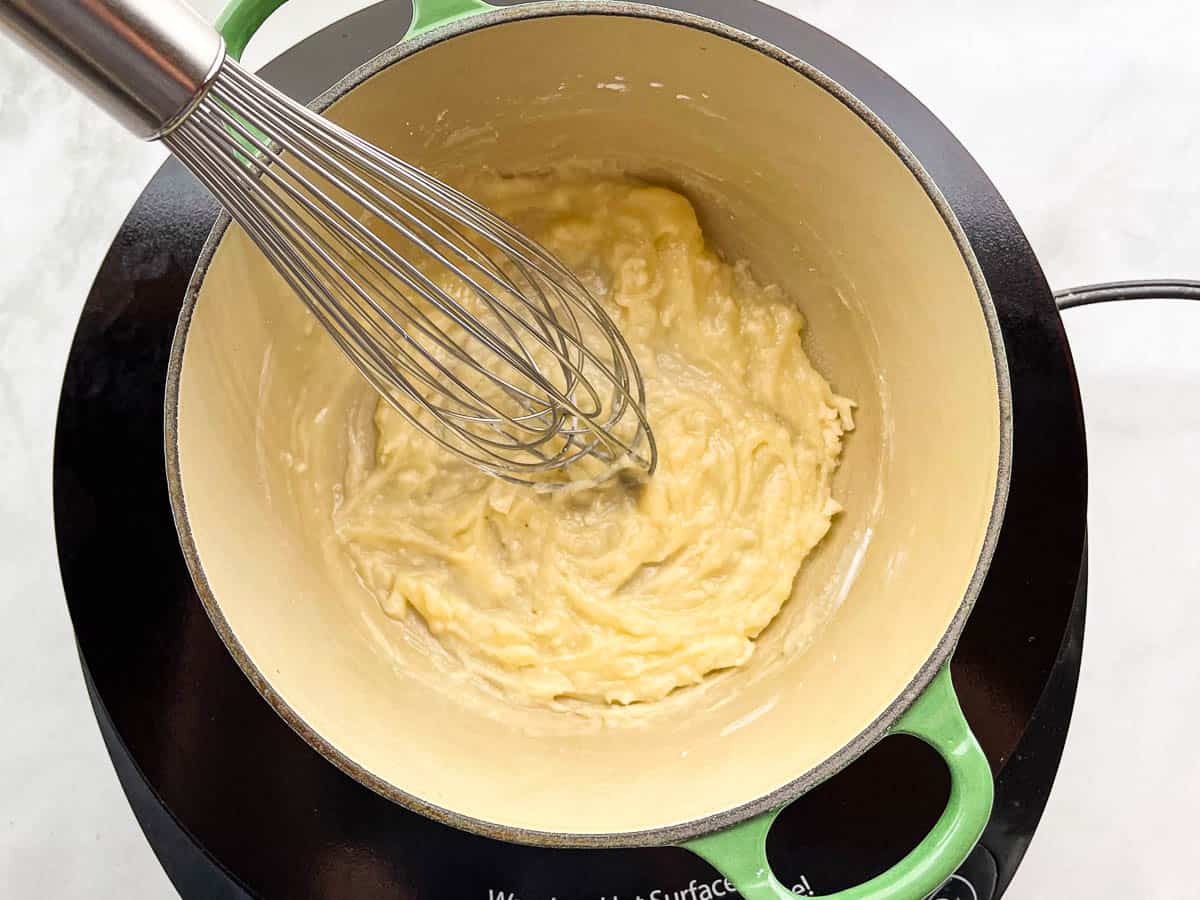
Heat the butter or fat in a pot. If you’re using butter, let it melt. If you’re using oil, heat until it simmers but doesn’t smoke.
Add the gluten-free flour and whisk. At first, the mixture will look thick and almost dry. As it cooks, it loosens a bit and looks like a thick paste. Whisk constantly as it cooks to prevent burning. For the best flavor, cook until the mixture turns golden brown.
Step Two: Slowly Add the Broth.
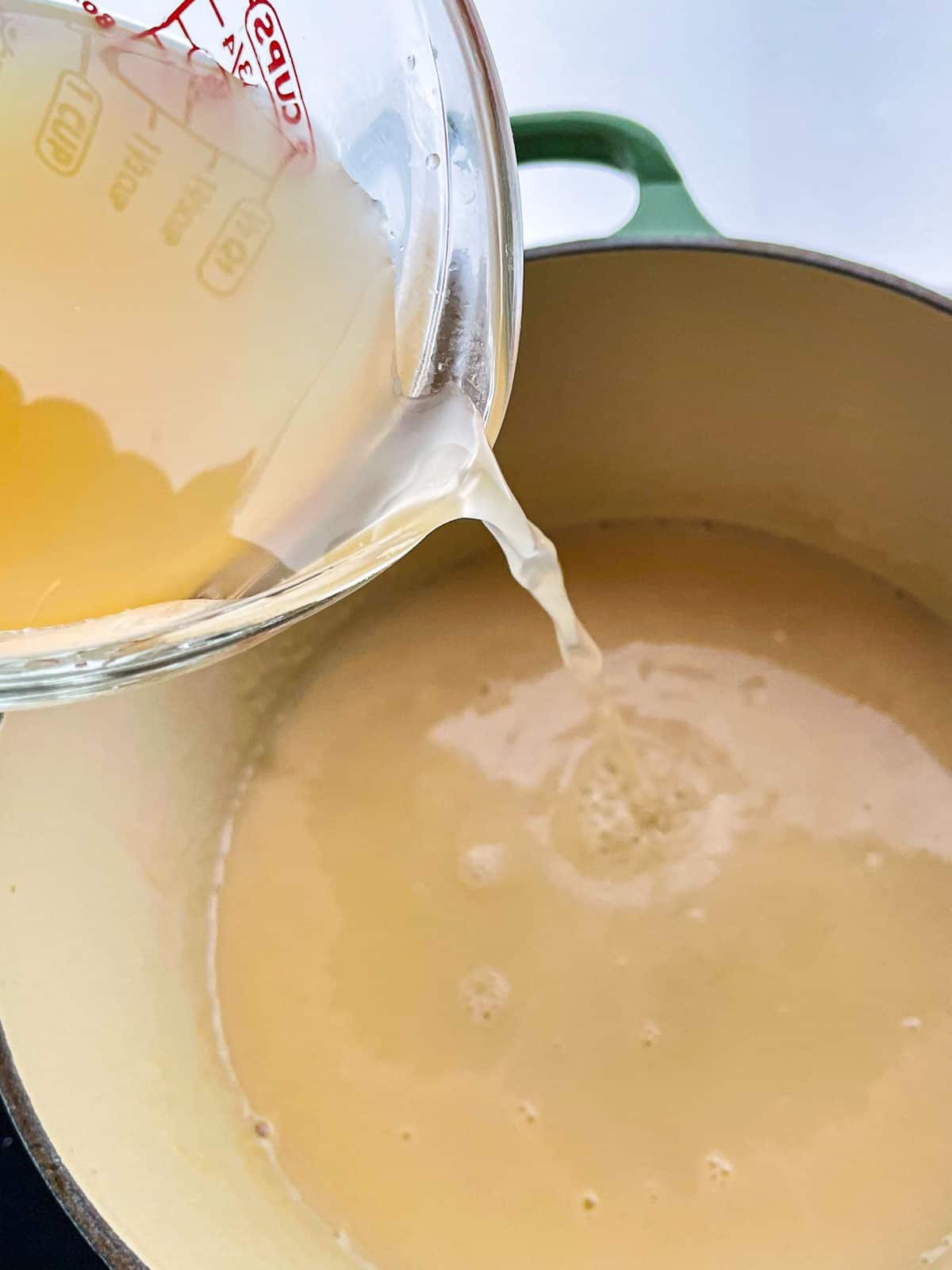
Add the warm broth in a slow stream. If you add it too fast, the roux can clump, making for a lumpy gravy. Whisk the gravy as you do this. You’ll see the roux swell and absorb the liquid.
Step Three: Bring to a Boil.
Bring the gravy to a boil. Then reduce the heat and let it simmer for about 10 minutes or until it reaches the consistency you like.
Step Four: Season to Taste.
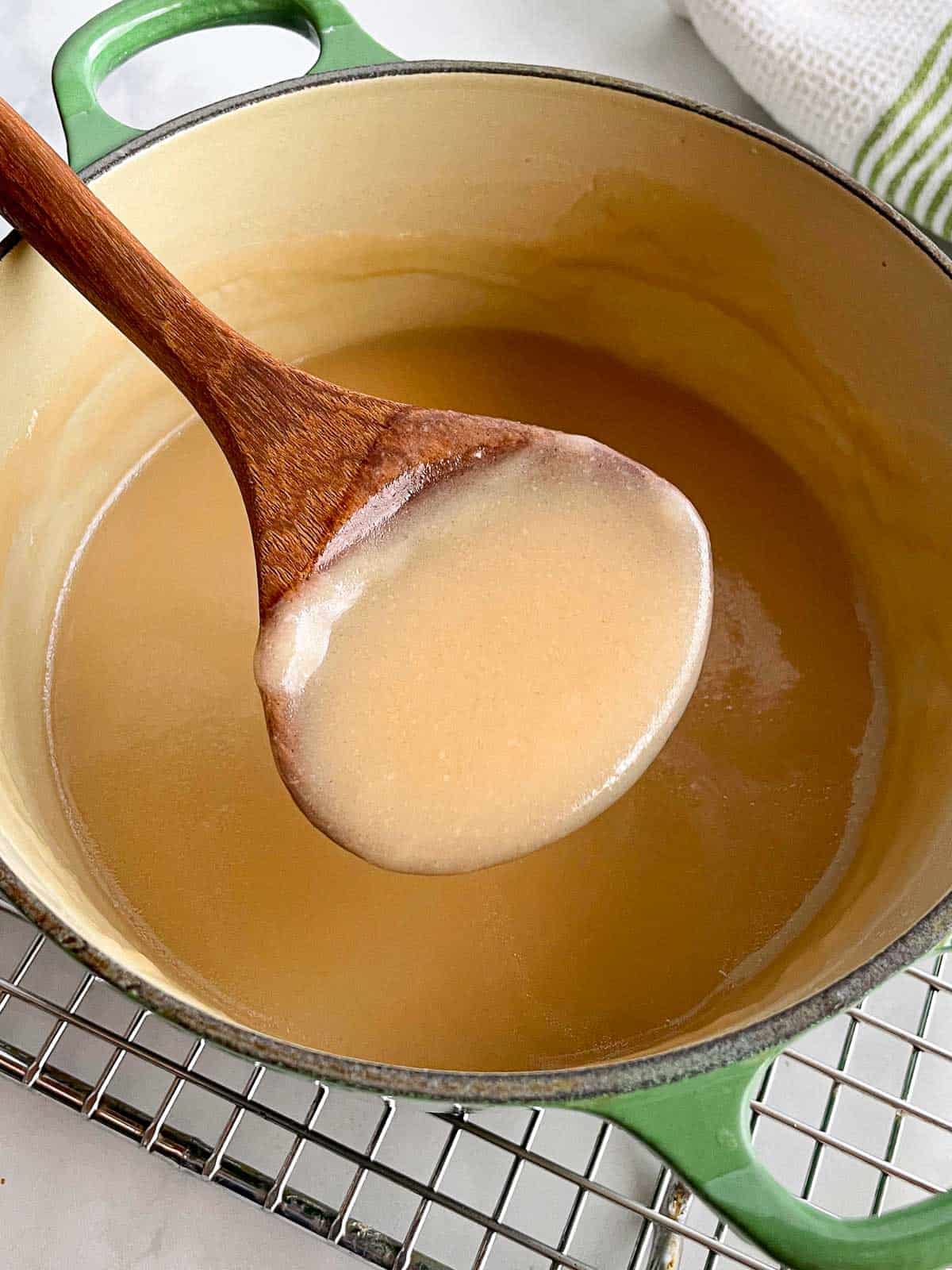
Season the gravy with salt and pepper after it’s simmered. As gravy simmers, it concentrates a bit. If you season it too early, seasonings, especially salt, can overwhelm the gravy.
Troubleshooting Gluten-Free Gravy.
Problem: Lumpy Gravy. Gluten-free gravy doesn’t clump as easily as a wheat flour-based gravy. But it can happen. If you notice your gravy is lumpy, it can be fixed.
First, try to whisk the gravy. Sometimes after a minute or so of vigorous whisking, the lumps go away. If that doesn’t work, blend the gravy on low speed with a blender, either a regular blender or an immersion blender. Or ladle the gravy through a fine mesh strainer. This is my least favorite method. It’s messy and requires more cleanup than using a whisk or blender.
Problem: Thin Gravy. If your gravy is too thin, whisk two teaspoons of cornstarch with a tablespoon of water. Add the cornstarch mixture into the gravy and bring it to a boil. (Cornstarch must be boiled to thicken sauces). Don’t add cornstarch directly to hot gravy. It can clump.
Problem: Thick Gravy. Gravy that’s too thick is an easy problem to solve. Whisk in additional stock or broth until it reaches the right consistency.
Problem: Salty Gravy. An overly salty gravy is unappetizing and can ruin a plate of food. There isn’t an easy fix for this. Although old kitchen wisdom says to add potatoes to salty gravy to “absorb the salt”, this doesn’t really work. The best way to fix this is to make a half batch of gravy without any salt. (If you’re using stock, make sure it’s salt-free.) Then combine the two. This usually fixes it.
How to Make Gluten-Free Gravy in Advance.
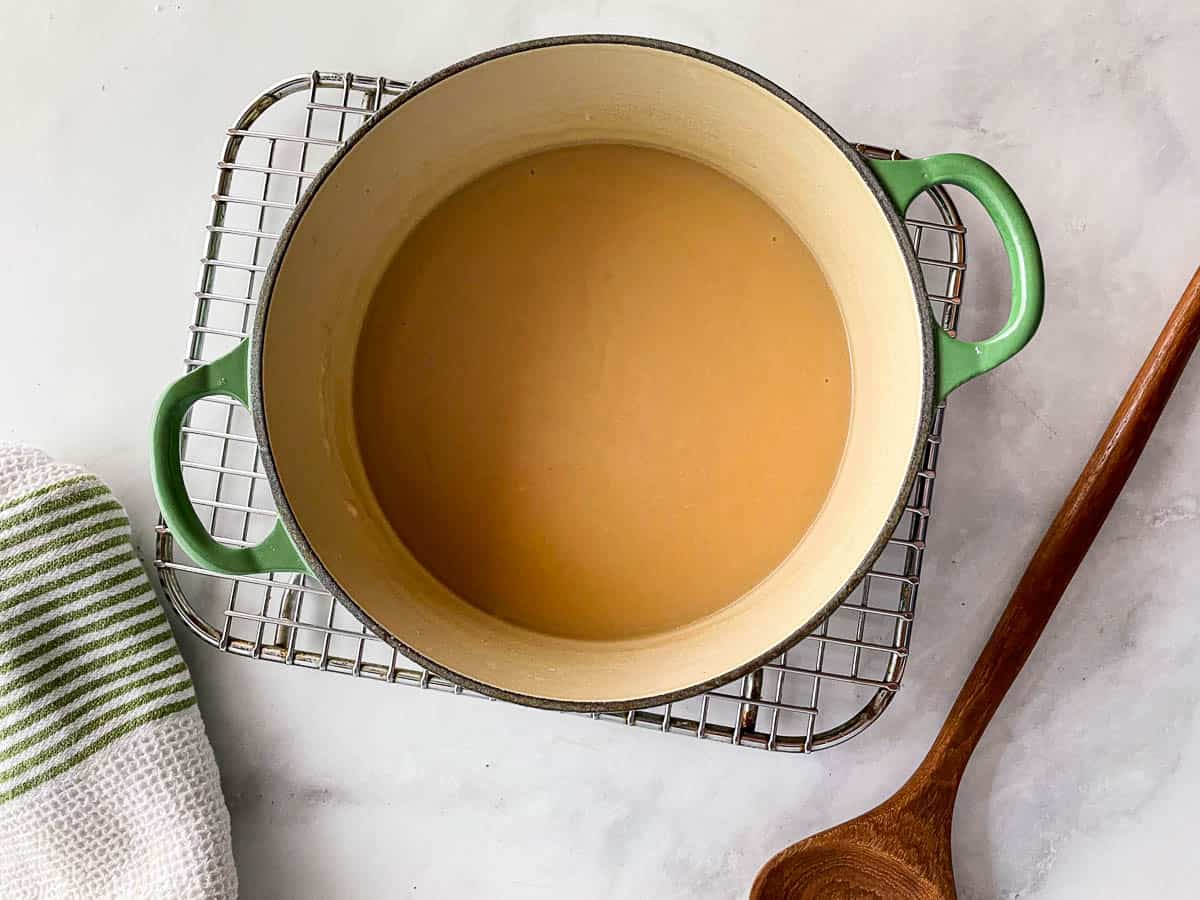
You can make gravy up to four days in advance. There’s no need to wait until Thanksgiving day to make it. Prepare as directed. Cool and store it in a covered container in the refrigerator. Right before serving, warm the gravy and add, if you’d like, add pan drippings.
Tips for Storing and Reheating.
Store leftover gravy in an airtight container. Refrigerate for up to four days.
To reheat: place the gravy in a small saucepan and heat over low heat. Stir occasionally as it heats.
Other Gluten-Free Thanksgiving Recipes You’ll Love.
- Gluten-Free Stuffing
- Gluten-Free Cornbread
- Gluten-Free Cornbread Stuffing
- Gluten-Free Soft Dinner Rolls
- Gluten-Free Pie Crust
- Gluten-Free Cranberry Orange Bread

How to Make Gluten-Free Gravy
Gluten-Free Gravy is easy to make. This recipe only requires three simple ingredients. The gravy is perfect for Thanksgiving or any meal!
Ingredients
- 3 tablespoons unsalted butter or olive oil (1½ ounces; 42 grams)
- 3 tablespoons sweet rice flour or white rice flour (¾ ounce; 21 grams)
- 2 cups warm turkey or chicken stock, see note (16 ounces; 453 grams)
- 1 teaspoon gluten-free soy sauce, optional
- salt and freshly ground black pepper
Instructions
-
In a small pot, melt the butter over medium-high heat. Or heat the oil until it shimmers but doesn't smoke.
-
Add the sweet rice flour and whisk until a paste forms. Continue whisking until paste turns light beige, about 3 minutes.
-
In a slow and steady stream, whisk in warm stock. Cook, whisking constantly, until gravy thickens and begins to bubble. Reduce heat. Simmer for 10 minutes.
Add soy sauce if using. Season with salt and pepper to taste.
-
Serve warm. Store leftover gravy in the refrigerator for up to four days.
Recipe Notes
Stock.
Homemade or store-bought stock can be used in this recipe. Be sure to use salt-free or low-sodium gluten-free turkey, chicken, or beef stock. If using gluten-free bouillion, reconstitute it according to package directions before adding to the gravy.
Roasting Liquid.
If you’d like to use roasting liquid, ladle the liquid into a bowl. Strain the liquid and then skim off the fat. Measure it. You’ll need two cups. Don’t use the roasting liquid if the bottom of the roasting pan is burnt. If you don’t have two full cups of roasting liquid, add stock until you have two cups.


Jennifer says
Turned out great! Doubled the recipe which worked well with 4 c. of stock. Seasoned with onion powder, garlic salt, crushed garlic, and pepper. Thank you for the recipe!
Elizabeth says
Yay!
Melissa says
Turned out great! I didnt have enough drippings so I used chicken broth for half. Yum!
Elizabeth says
Yay!
Samantha Johnston says
Quick comment. I didn’t have the images in front of me when I just prepares – just the printed recipe. When you melt the butter and add the flour, it really doesn’t form a paste even after a few minutes. Because of this, I added more flour thinking I made a mistake! It wasn’t until I started adding the broth that it thickened up tremendously – so I added too much flour and it’s very thick!! That said, I plan to add pan drippings when I cook the turkey so hopefully that will thin it out. Tastes good though and the texture is very smooth. Side note – sweet rice flour not too easy to find in normal grocery or While Foods. Ordered Mochiko from Amazon.
Strollfoodie says
As I glanced on making gluten-free gravy, it was easy to make when using some turkey stock with equal parts of brown rice flour and olive oil. But we did added these spices to have a better tasting gravy, we added 2 teaspoons of each -garlic and onion powder. 1 Tablespoon of fresh thyme, chopped. Salt and pepper to taste. It will develop the flavors after the gravy has been cooked and cools down. Yummy!!!
Jody Richter says
Great recipe, used white rice flour. Thank you
Clare says
BEST gluten-free gravy EVER. Thank you! The recipe will save Thanksgiving. I did a trail run this weekend because last year’s gravy was an abomination!
Ashley says
Best gluten-free gravy I’ve ever made! Thank you!
Karin says
This is a fantastic recipe! I have to cook for family members that are GF, soy free, dairy free, and never made a GF gravy. I found your recipe and was intrigued by the sweet rice flour. Thanks to your info, found it on Amazon, worth every penny for these results and to be able to give my loved ones gravy they can eat! It is the best gravy I have ever eaten and super easy to make! Thank you!! I did use chicken stock because we didn’t have turkey.
Jennifer says
I made this with smoked ham drippings. There’s so much liquid to work with. Soooooo flavorful and delicious! I’ve never made such delicious gluten free dressing! My husband had “normal” gravy and he was jealous of mine. 🙂 Thank you for this recipe.
Elizabeth says
That sounds SO GOOD! Happy Thanksgiving!
Barbara Bolden says
Love it love it! Just made a shrimp stir fry and needed a sauce/ gravy To put together with rice. I am in heaven right about now! Came out better than I expected. Thank heaven. There is a God!
Sally Jones says
Have you ever tried Tapioca flour added to stock, mixed well, them poured into the fat in the roasting tin and heated until thick and smooth. so easy
Elizabeth says
Yes! I like starch-thickened gravies. They’re great and so easy! For Thanksgiving, I prefer a roux gravy because I like the flavor a bit more.
Cassandra says
WOW!!! First time I have successfully made gravy from scratch….LOL!! I couldn’t do it with regular flour before I had to go GF. THANK YOU SO MUCH!!! We had a decent Thanksgiving because of this recipe.
Brittany says
Looking up last minute GF Gravy recipes for Thanksgiving 20min before dinner is served, you know, no big deal! Decided to try this one but I didn’t have sweet rice flour. Ended up using regular GF flour because that’s all I had. Surprisingly turned out perfect! Even my non-gluten free family loved it! So smooth and great flavor.
Arlete says
Thank you so much for this recipe. This was my first time making it from scratch and I was a little insecure until I tried it out and my family eat it. Success! Will be making it always for holidays. Thank you so much.
Christina says
Came out great, thanks! My Hubby ( who does not cook) has gone gluten free on me? I’ll look for more yumminess from you.
Monica says
Hi!
Did as you said got the roux to a slight tan but when all is said and done it’s slightly gritty. Any advice. Taste etc is good. Can I do something? Thanks my turkey gravy last month was gorgeous.
Elizabeth says
Ohhh…good question. If it’s gritty, that’s how the flour was milled. They tend to vary a lot from brand to brand. It might get a little better overnight. If you are planning on making another batch, I’d try a different flour.
Wish I had an easier answer for you!